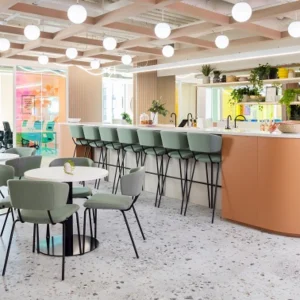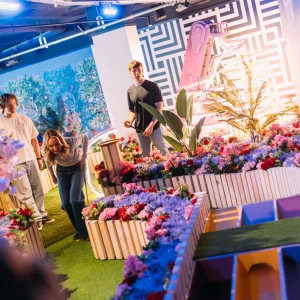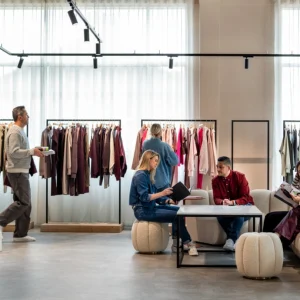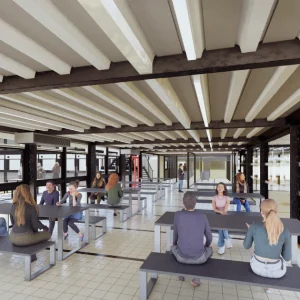
In August this year hundreds of young Warsovians thronged around a newly refurbished railway kiosk in a run-down part of the Polish capital’s downtown. Once a dilapidated, Communist-era municipal building – typical of Warsaw for its severe steel-frame structure and expressive parabolic concrete roof – the kiosk has been transformed into a café featuring installations, talks, events and parties for the city’s young art crowd. Yet this apparently low-key conversion, designed by the architecture group Centrala, is more than just a pragmatic adaptation: it is representative of an emerging generation of designers in Poland, who are deeply concerned with their country’s Soviet-era architectural heritage.
Centrala’s core members are Ma?gorzata Kuciewicz, Krzysztof Banaszewski and Jakub Szczesny: all in their late twenties or early thirties, they have been working together since 2002, when they collaborated as students of the Technical University of Warsaw. Centrala focuses on projects for architectural competitions, often proposing schemes that are provocative rather than pragmatic. These have included turning the gardens of Warsaw Central Station into the enclosed Central Park and a proposal for the city’s national sports stadium (scheduled to open in time for the Euro 2012 football tournament), which focused on creating an infrastructure of public space and communication networks. The re-interpretation and re-activation of Soviet-era architecture is, however, a fundamental element of Centrala’s practice and one that it shares with many other architects of its generation.
Projects such as the Warsaw Powisle cafe are, in many ways, an act of rebellion against a general public that finds little to like in these increasingly decrepit relics, but also in opposition to the shopping malls and office blocks that dominated Poland for most of the 1990s and first decade of the 21st century. It is no accident that the concrete planters, which define the boundaries of the cafe’s public space, were taken from the rubble of the last major Soviet-era building to be demolished: a huge supermarket called Supersam. Yet as much as they are fighting for preservation, they are also stimulated by Poland’s post-war architectural heritage to create new work.
One example is the work of Warsaw based practice 137 kilo, founded by Zofia Strumi??o and Jan Sukiennik in 2006. Sukiennik sees Poland’s Communist-era buildings as a ‘treasure trove of national architecture’ and finds many gems among the public-use buildings from the 1960s, 1970s and 1980s. ‘They evoke a modern Polish identity that evolved in Socialist confines,’ he says.
Although Sukiennik describes the buildings from this era as a ‘huge inspiration’, he considers this influence to be more about a purity of form and clarity of purpose than ideological intent. One can see this clearly in the practice’s collaboration with WWA – the architect behind the Polish pavilion at the World Expo 2010 Shanghai – on the Sluzewiecki Cultural Centre for Warsaw. A mix of workshops, public space and educational facilities, along with a concert hall, gallery and restaurant, have been contained within a simple and clearly resolved series of buildings, which are partly submerged beneath a narrow area of parkland.
In Wroclaw, which, like Warsaw, was largely destroyed towards the end of the Second World War and rebuilt under Soviet rule, the same impulse among emerging architects can be observed. VROA, a practice led by Marta Mnich and Lukasz Wojciechowski (both of whom have only recently turned 30) has designed an extension to a restaurant pavilion created by German architect Max Berg, who devised Warsaw’s extraordinary Centennial Hall nearby. Wojciechowski has just published a book on the Socialist architecture of Wroclaw and campaigns vociferously for the retention of deeply unfashionable buildings.
Architecture critic and co-curator of RIBA’s forthcoming exhibition, Open:Poland, Grzegorz Piatek sees the attitude of these young architects as integral to a process of self-discovery, mingled with a certain degree of national pride. ‘They are looking for the ingredients of a national identity. In those hard times, when materials were scarce, and huge amounts of housing had to be built, you had to work fast and to harsh standards. Even then, architects were able to pull off amazing, pure forms,’ he says.
The work of these architects also reflects a wider debate about Polish identity. In 2006, the Warsaw Uprising Museum opened to commemorate the revolt of 1944, the defining moment of the city’s modern era. It remains a contentious institution because of the blame that it places on Stalin for failing to support the Poles’ fight against the occupying Nazis. Arguments such as this remain potent: at the beginning of September, as solemn commemorations of the outbreak of the Second World War began, an emotive debate erupted between the Polish and Russian governments about the causes of the War. Russia’s secret intelligence service said it was about to declassify documents that revealed culpability on the part of Poland for its invasion by the Nazis; and the Polish Prime Minister, Donald Tusk, gave a strongly worded speech at an international memorial service in Gdansk, in which he urged the world to ‘remember who started the war, who the culprit was, who the executioner was in the war, and who the victim was of this aggression’.
The row served as a reminder that Poland’s current self-image remains tied to its tumultuous 20th-century history. In a country with borders that have changed many times over the last 70 years, where two of the largest cities – Warsaw and Wroclaw – have been largely destroyed and rebuilt by successive political regimes, every discussion of national identity begins with debates about the past. Since Poland joined the European Union in 2004, the issues of national and local identities have become even more urgent, and architecture has played a vital role in discussions. As Tomasz Fudala, curator at Warsaw’s nascent Museum of Modern Art says: ‘In the rest of the world, the discussion about Socialist architecture and modernism has gone or moved on. But here it is still a vital concern.’ In Warsaw and Wroclaw, the fight to preserve and adapt buildings from the Communist era is a continuation of arguments about the country’s ideological past. Yet it also indicates the more open-minded attitudes of young architects.
This interest in national and local identities is a major theme of RIBA’s exhibition. It explores the ways in which architects are seeking to find a uniquely Polish expression in their work and examines where such an architectural identity might come from. Piatek sees the ideas behind the show as universal: ‘we chose it not because it is just a problem for Poland, but for countries around the world. How do you express identity when projects are determined in such a globalised way?’ Yet he acknowledges that these questions hold particular resonance in his home country: ‘as a nation we have been very eager to accept new technology and new lifestyles, because it’s part of modernising the county and catching up with modern lifestyles’.
Poland’s EU membership has had a very direct effect on the architectural expression of Polish identity: in the last five years there has been a spree of museum commissioning and building. In Warsaw alone, there will soon be the Museum of the History of the Polish Jews, the Museum of Modern Art, the Polish Army Museum and the Copernicus Science Centre. These projects all date from competitions run around 2005 – the year after Poland joined the European Union – and are co-funded with EU money: they are symptomatic of a country concerned with issues of identity, and a catalyst for debates on the matter. ‘After 1989 there were many private investments, such as skyscrapers or shopping malls, but it’s difficult for our authorities and our bureaucracy to start thinking about public buildings and about our representation of the city,’ says Fudala.
The Warsaw Museum of Modern Art, temporarily housed in a disused department store, will soon occupy a new building in the shadow of the grand Stalinist Palace of Culture. The project had a particularly troubled gestation. In the original design competition for the building, held in 2006, four judges including Deyan Sudjic and Tate director Nicholas Serota walked out after an outcry over the rules, which Sudjic described as ‘Kafka- esque’. Organisers had initially stipulated that all entrants must be members of the Polish Chamber of Architects, and that they must provide a sworn statement, in Polish, that no practice directors had a criminal record. The competition was abandoned, only to be relaunched in 2007 after the rules were relaxed, and the jurors reinstated.
Despite the unpredictable process, the outcome of the competition could not have been calmer: an understated piece of rigorous minimalism by Swiss architect Christian Kerez. That result has set a precedent for most of the major architecture competitions in Poland ever since: almost all have been won by small or medium-sized European studios. There is one important exception, though: in mid- September the winner of a competition to design the Polish Army Museum in Warsaw was announced as being the young, local practice WXCA. To be built in the grounds of the historic Warsaw Citadel in the Zoliborz district, its project is emblematic of two trends in Polish architecture: the construction of an extraordinary number of new museums, exploring specific elements of Polish history, and the ability of young architects to win culturally significant work.
The architects who blazed the trail for these emerging practices do not, however, come from one of Poland’s major cities. Medusa Group, founded in 1997, has found particular rich inspiration in Silesia, the densely populated post-industrial region between Gliwice and Katowice. It seems an unlikely setting: ‘Warsaw will always remain the most important city; that’s where everything comes together. Then, in order of importance come Poznan, Wroclaw and Gdansk. Only after these can you talk of the former coal mining area,’ says Przemo Lukasik, who founded Medusa with his wife Joanna. However, the area has provided a perfect arena for experimentation: ‘Silesia is like a playground because it has this high concentration of industry, and that means it has the right preconditions for architects like us,’ says Lukasik.
The attachment of Polish architects to their own country, and often their own specific region or city, is remarkable. Even a well-established and highly successful practice such as JEMS, founded in the 1980s, whose Agora media company building is one the Warsaw’s most remarkable contemporary structures, has rarely taken on projects beyond the limits of its home city and never outside of Poland. In part this has been a result of necessity rather than idealism: the dearth of significant public projects in Poland over the last 20 years has meant that a whole generation of the country’s architects have had little or no experience in building the large cultural or infrastructural projects, which are often
the subject of international competitions.
Yet this is not the full story: for many of the younger generation of Polish architects, the issues of local and national identity are considered central to their practice. The architects of 137 kilo, VROA, WWA and Medusa all worked abroad before deciding to move back to their home country. ‘For a young architect, to contribute to the building of his own country is surely the most appealing task possible. Coming back after twelve years outside the country was tremendous. While we were based in Berlin, the Polish border suddenly seemed to be just a stone’s throw away,’ says Lukasik.
It would be wrong, though, to see contemporary Polish architecture as a mix of introspection and retrospection. Two recent projects demonstrate a more relaxed attitude to the past and a confident approach to the future and the international scene. WWA’s pavilion for the World Expo 2010 Shanghai is, as Piatek makes clear (see page 29), a bold project that demonstrates the feasibility of a young practice managing a project in Beijing while remaining in Warsaw. Another key project is the redeveloped Renoma building in Wroclaw. In many ways the design, by Mácków Architects, was able to bypass the contentious issues that arise from dealing with many of Poland’s historic structures: the Renoma is Poland’s only surviving Wertheim department store, completed in 1930, when, as critic Jerzy S Majewski said, ‘Polish architecture was not very different from the general trends in Europe.’ Nevertheless it is a grand and well-loved building: the modern extension continues the rhythm of its facade, while adding a bit of contemporary drama with a more faceted shape form.
With ample opportunities to work on such historically and culturally interesting projects, it is in some ways no wonder that the country’s young architects are staying home. However, that may not be for long. ‘No doubt the regional aspect plays a big part, but I could just as easily imagine tendering for a job in São Paulo, why not? We are not tied to this place,’ says Lukasik, ‘We shall always be looking for whatever one human being can give to another – especially in situations where the original cultures are foreign to each other. It’s all a question of dialogue.’ It is likely that in the coming years, Poland’s talented young architects will be making a bigger impact on the world stage.
Open:Poland – Architecture and Identity?is on at RIBA, London, W1, until 25 November





